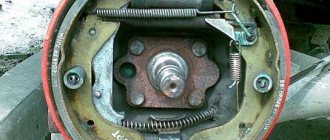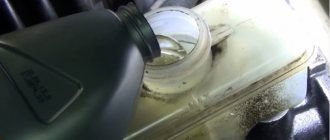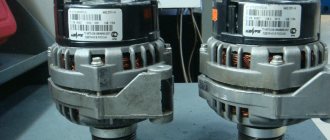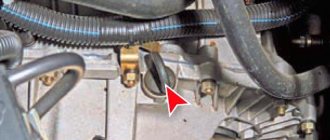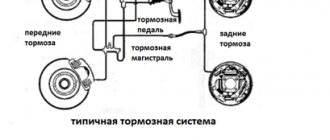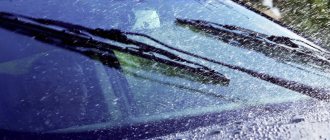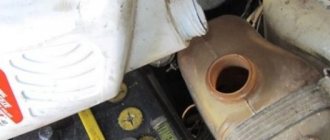Installation
Install the sensor in reverse order.
I myself had the same thing, although on a service car 2114. This really means a low brake fluid level. But this is also a signal that the brake pads and/or brake discs are worn out! Even if the level of brake fluid is normal, when braking to the floor, the “stroke length” of the brake calipers with worn pads and discs is simply higher than if both were “normally worn.” I knew about this “effect” and immediately looked at the wear of the discs and pads; the pads were very worn out. I got some brake fluid from a colleague and topped it up a little, but little changed. But when I changed the pads at the scheduled maintenance of 15000 (all the service technicians came running to see how in the fall and winter, 15,000 km away, the oak Egoryevskie pads could be erased to zero, while the discs were absolutely not worn out, only “polished”) - then the light bulb stopped burn. So first you should look at the condition of the brake pads and discs - maybe this is the reason for the “long stroke” of the calipers and the low level of brake fluid?
How to tell if brake fluid is leaking
You can recognize a leak in the brake system by the fluid level in the reservoir. If its level approaches the minimum mark, then a leak occurs. Also, the “!” indicator should light up on the dashboard, indicating a critical lack of fluid for the brake system. But this does not always happen, so you need to control the level manually.
Brake fluid level indicator
You can accurately understand that there is a fluid leak by making a test top-up in the expansion tank. If after this there is a sharp drop in its level, then the brake fluid leaves.
First of all, in such a situation, you need to check the expansion tank itself for cracks. If they are, the brake fluid tank must be replaced.
Which brake fluid should I choose?
The abundance of technical fluids for a car makes the procedure for choosing a technical fluid quite complicated. Marketing gimmicks and an excessive amount of information on a bottle of “braking fluid” should not be the only reason to buy. You should choose a TJ based on the following characteristics:
- The viscosity of the liquid must remain the same at any temperature;
- The presence of boric acid in the composition, which neutralizes moisture;
- Ability to maintain effectiveness at high temperatures.
Several types of fuel fluid are classified, but most often drivers use DOT 4 class fluid. The basis of liquid from this class is compounds of esters with boric acid. This composition helps to preserve properties at any time of the year.
We recommend considering the following TJ options for purchase:
- "Dzerzhinsk brake fluid". Designed for use in hydraulic drives of brake systems and clutches of domestic and imported cars. Compatible with all domestic and imported glycol-based fluids. It has a boiling point of more than 2300C. The price of a 900 gram bottle is 160 rubles.
- TJ from . The modified composition of the Bosch version is sold at a price of 400 rubles per liter. Endowed with improved characteristics against the formation of steam bubbles at high temperatures and increased intervals between replacements (up to 2-3 years).
As you can see, the price for this technical fluid is acceptable, so you should not save and look for the cheapest option. A low-quality vehicle can fail at the wrong moment. Also, when purchasing, check the product for counterfeit. It is recommended to purchase “brake guards” at trusted points of sale.
Vehicle malfunctions leading to replacement of the vehicle with a VAZ 2114
The hydraulic brake system includes many different parts that allow you to operate the brakes using hydraulic fluid. It includes:
- a tank that is attached to the gas turbine engine and is intended for filling the fuel fluid;
- metal pipelines of both circuits;
- flexible brake hoses of front and rear wheels;
- GTZ installed in the engine compartment;
- working brake cylinders of front and rear wheels;
- dual-circuit pressure regulator;
- a sensor showing at what level the fuel fluid is located;
- a vacuum booster, the task of which is to create working fluid pressure in the pipelines of the circuits in order to ensure effective operation of the brake systems on the wheels during braking.
A car’s vehicle is one of the main systems that ensures the safety of the driver and passengers of the car, therefore regular preventive inspection of all elements of the vehicle is mandatory for the owner of the car.
The brake fluid on the VAZ 2114, according to the recommendations of technical specialists, is replaced every three years or no more than after 45 thousand kilometers of the vehicle.
At the same time, during the operation of a vehicle, malfunctions periodically occur in its braking system and especially in the hydraulic drive, leading to the need to replace the brake fluid. Knowledge of these malfunctions and the reasons leading to them can help the driver avoid serious troubles on the road, since in this case he can promptly identify the failure and take measures to eliminate it.
Malfunctions in the vehicle resulting in the need to replace the vehicle:
- Leaks from the working brake cylinders leading to significant loss of fuel fluid.
- The formation of air pockets in main pipelines and flexible hoses, which are formed as a result of leaks in vehicle units.
- Rupture or fraying in the flexible hoses on the wheels, in this case the brake hoses on the VAZ 2114 need to be replaced. Damage to metal pipelines is also possible; as a rule, a leak forms due to “chasing”. In both cases, the liquid quickly flows out of the vehicle, so at the slightest sign of disorder in the vehicle, these parts should be checked first.
- Damage or swelling of the sealing rings in the GTZ or wheel cylinders. This also leads to leaks.
- Leakage of fuel fluid through the sealing rings of the rear wheel RD pusher.
- There may be a leak in one of the brake circuits. In this case, partial failure of the brake pedal occurs.
- Quite rarely, but metal pipelines become clogged.
- As a result of mechanical damage, failures of the GTZ, RTC, vacuum unit and other vehicle elements are possible. To eliminate these damages on the VAZ 2114, replacing the brake fluid is a prerequisite.
How much to buy
The VAZ 2114 system has a volume of 750 milliliters. Taking into account pumping and unforeseen situations, one liter is enough. There will be some left over for topping up. There is no need to carry it with you and constantly top up the pillbox. You can buy it in any quantity at any gas station. Motorists who have been driving for several years can always find out how much brake fluid is in the VAZ2114 system.
It must be remembered that DOT-4 is extremely toxic, so spilling it on open skin is highly undesirable. Therefore, it is not worth storing it in the trunk.
Brake fluid replacement process
If you decide to change the brake fluid on your VAZ 2114 yourself, you should prepare the necessary tools in advance and invite a friend. It is difficult to perform such a procedure alone, so to save time you should find an assistant.
The step-by-step process of replacing DOT 4 in the “four” looks like this:
- Stop the car on an overpass or pit.
- Remove the cap from the TJ tank and move to the rear right wheel.
- Remove the cap from the bleeder fitting.
- Take an empty container and fill it with some DOT 4.
- Next, put the hose on the fitting and lower its second end to the bottom of the container with the “brake housing”.
- Now you should press the brake pedal about 7-9 times. For this you will need an assistant.
- Unscrew the fitting a few turns and, while pressing the pedal, drain the used DOT-4.
- When there are a couple of centimeters of brake fluid left in the reservoir, screw the fitting back on and release the pedal.
- Fill the tank to the maximum level and continue the procedure until pure DOT-4 comes out of the tube.
- Carry out this procedure on the remaining wheels.
Important! When carrying out work, the following order should be observed: rear right wheel, front left, rear left and front right.
In order to prevent air from entering the system, do not allow the liquid level in the tank to drop to a minimum. Periodically check the brake fluid reservoir for leaks or damage. Damaged brake hoses that allow air into the system can also be a reason for changing the fluid. Despite the fact that the durability of hoses is high, there is always a risk of mechanical damage due to friction if installed incorrectly.
Keep in mind that the “four” system includes about 800 milliliters of DOT-4, so to carry out all pumping procedures you will need at least one liter of TJ. You should not mix different types of fuel fluid with each other. If the system previously used DOT-3, then the new class of “slurry” should be filled only after the old waste has been completely drained.
What does DOT consist of?
As mentioned above, the chemical composition is extremely toxic. They contain a castor oil base. However, this element is gradually becoming obsolete and brake fluids based on helicols are increasingly appearing (they cannot be mixed with regular fluids). The presence of additives in both types provides a good lubricating and anti-corrosion effect.
Some drivers don’t even know where to fill the brake fluid in the VAZ 2114 (even though the VAZ brake fluid reservoir is visible), not to mention the rules. DOT-4 needs to be added only if its level in the tank has dropped below the halfway point between the MIN and MAX marks. To do this, simply unscrew the tank cap and fill it to the top mark. The brake fluid volume should not exceed the maximum mark.
Do not under any circumstances mix products from different manufacturers and brands. This may lead to system failure, which will adversely affect your financial situation when contacting the service. Be sure to ask an expert how to add brake fluid.
In general, if all necessary conditions and rules are observed, everything is done quite simply. Any measures to normalize the operation of a car require certain tools and special clothing. This should not be forgotten, since contact with human skin of chemicals contained in fuels and lubricants is extremely dangerous to health.
But whatever one may say, in the quest for durability and reliability of your car there is nothing you can do. The acquired skills can be applied not only to the VAZ 2114, but also to other models of the domestic automobile industry. For example, the VAZ 2115 has an absolutely identical device.
